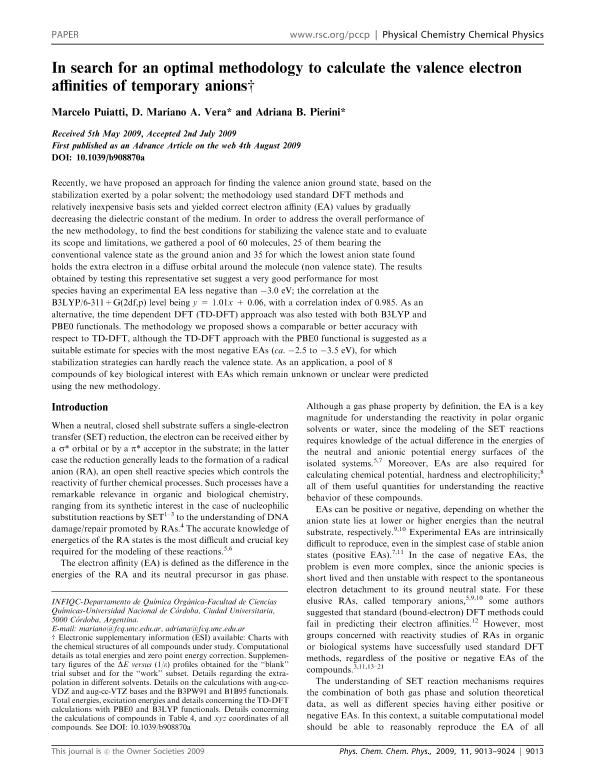Mostrar el registro sencillo del ítem
dc.contributor.author
Puiatti, Marcelo

dc.contributor.author
Vera, Domingo Mariano Adolfo

dc.contributor.author
Pierini, Adriana Beatriz

dc.date.available
2019-05-15T19:31:26Z
dc.date.issued
2009-08
dc.identifier.citation
Puiatti, Marcelo; Vera, Domingo Mariano Adolfo; Pierini, Adriana Beatriz; In search for an optimal methodology to calculate the valence electron affinities of temporary anions; Royal Society of Chemistry; Physical Chemistry Chemical Physics; 11; 40; 8-2009; 9013-9024
dc.identifier.issn
1463-9076
dc.identifier.uri
http://hdl.handle.net/11336/76445
dc.description.abstract
Recently, we have proposed an approach for finding the valence anion ground state, based on the stabilization exerted by a polar solvent; the methodology used standard DFT methods and relatively inexpensive basis sets and yielded correct electron affinity (EA) values by gradually decreasing the dielectric constant of the medium. In order to address the overall performance of the new methodology, to find the best conditions for stabilizing the valence state and to evaluate its scope and limitations, we gathered a pool of 60 molecules, 25 of them bearing the conventional valence state as the ground anion and 35 for which the lowest anion state found holds the extra electron in a diffuse orbital around the molecule (non valence state). The results obtained by testing this representative set suggest a very good performance for most species having an experimental EA less negative than -3.0 eV; the correlation at the B3LYP/6-311+G(2df,p) level being y = 1.01x + 0.06, with a correlation index of 0.985. As an alternative, the time dependent DFT (TD-DFT) approach was also tested with both B3LYP and PBE0 functionals. The methodology we proposed shows a comparable or better accuracy with respect to TD-DFT, although the TD-DFT approach with the PBE0 functional is suggested as a suitable estimate for species with the most negative EAs (ca.-2.5 to -3.5 eV), for which stabilization strategies can hardly reach the valence state. As an application, a pool of 8 compounds of key biological interest with EAs which remain unknown or unclear were predicted using the new methodology.
dc.format
application/pdf
dc.language.iso
eng
dc.publisher
Royal Society of Chemistry

dc.rights
info:eu-repo/semantics/openAccess
dc.rights.uri
https://creativecommons.org/licenses/by-nc-sa/2.5/ar/
dc.subject
Negative Electron Affinity
dc.subject
Radical Anions
dc.subject
Dft
dc.subject
Td-Dft
dc.subject.classification
Otras Ciencias Químicas

dc.subject.classification
Ciencias Químicas

dc.subject.classification
CIENCIAS NATURALES Y EXACTAS

dc.title
In search for an optimal methodology to calculate the valence electron affinities of temporary anions
dc.type
info:eu-repo/semantics/article
dc.type
info:ar-repo/semantics/artículo
dc.type
info:eu-repo/semantics/publishedVersion
dc.date.updated
2019-05-06T14:15:47Z
dc.journal.volume
11
dc.journal.number
40
dc.journal.pagination
9013-9024
dc.journal.pais
Reino Unido

dc.journal.ciudad
Cambridge
dc.description.fil
Fil: Puiatti, Marcelo. Consejo Nacional de Investigaciones Científicas y Técnicas. Centro Científico Tecnológico Conicet - Córdoba. Instituto de Investigaciones en Físico-química de Córdoba. Universidad Nacional de Córdoba. Facultad de Ciencias Químicas. Instituto de Investigaciones en Físico-química de Córdoba; Argentina
dc.description.fil
Fil: Vera, Domingo Mariano Adolfo. Consejo Nacional de Investigaciones Científicas y Técnicas. Centro Científico Tecnológico Conicet - Córdoba. Instituto de Investigaciones en Físico-química de Córdoba. Universidad Nacional de Córdoba. Facultad de Ciencias Químicas. Instituto de Investigaciones en Físico-química de Córdoba; Argentina
dc.description.fil
Fil: Pierini, Adriana Beatriz. Consejo Nacional de Investigaciones Científicas y Técnicas. Centro Científico Tecnológico Conicet - Córdoba. Instituto de Investigaciones en Físico-química de Córdoba. Universidad Nacional de Córdoba. Facultad de Ciencias Químicas. Instituto de Investigaciones en Físico-química de Córdoba; Argentina
dc.journal.title
Physical Chemistry Chemical Physics

dc.relation.alternativeid
info:eu-repo/semantics/altIdentifier/doi/http://dx.doi.org/10.1039/b908870a
dc.relation.alternativeid
info:eu-repo/semantics/altIdentifier/url/https://pubs.rsc.org/en/content/articlelanding/2009/CP/b908870a#!divAbstract
Archivos asociados
